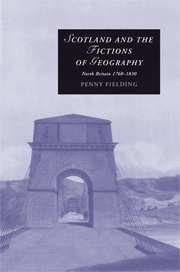Book contents
- Frontmatter
- Contents
- Acknowledgements
- Introduction
- 1 North Britain
- 2 Burns, place and language
- 3 Great North Roads: The geometries of the nation
- 4 Antiquarianism and the inscription of the nation
- 5 Ultima Thule: The limits of the north
- 6 Norths: James Hogg and post-Enlightenment space
- Notes
- Bibliography
- Index
- CAMBRIDGE STUDIES IN ROMANTICISM
4 - Antiquarianism and the inscription of the nation
Published online by Cambridge University Press: 05 May 2010
- Frontmatter
- Contents
- Acknowledgements
- Introduction
- 1 North Britain
- 2 Burns, place and language
- 3 Great North Roads: The geometries of the nation
- 4 Antiquarianism and the inscription of the nation
- 5 Ultima Thule: The limits of the north
- 6 Norths: James Hogg and post-Enlightenment space
- Notes
- Bibliography
- Index
- CAMBRIDGE STUDIES IN ROMANTICISM
Summary
Scott's third novel, The Antiquary (1816), is a story that takes place in an impossible location and one that seems to confound the geometries of Great Britain discussed in the previous chapter. Its titular antiquarian obsesses fruitlessly about the location of the last battle between the Romans and the British. Fairport, where most of the action happens, is described in ways that situate it both on the north and the east coasts of Scotland. Yet, these puzzling localities are the scene of important debates about the nation and its geography. Like Waverley and Rob Roy, this novel features a young man journeying north, the paradigm of the national tale in which a traveller from the national ‘centre’ visits the supposed peripheries of the country in order to investigate their differences and to reabsorb them into a United Kingdom. In an even more down-to-earth way, the novel is interested in its own topography: where things can be found and what places are ‘really’ called. The very title introduces a tension between these two ideas about place: the nation as modern state or geographical area can be conceived only in overview and understood only as a general concept, while antiquarianism produces its effects from the individual or the atypical. A number of recent commentators remark on this tension. Mike Goode shows how, in contrast to philosophical history, antiquarianism works ‘by privileging the particular over the general, the rare over the representative, and the empirical over the theoretical’.
- Type
- Chapter
- Information
- Scotland and the Fictions of GeographyNorth Britain 1760–1830, pp. 101 - 129Publisher: Cambridge University PressPrint publication year: 2008

